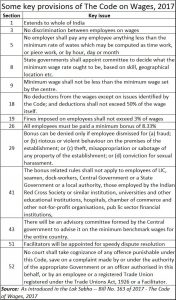http://www.freepressjournal.in/editorspick/rn-bhaskar-code-on-wages-bill-and-dream-of-jobs-for-all/1132793
Can the Wages Code scuttle the PM’s dream of jobs-for-all?
— By | Sep 07, 2017 07:41 am
On 10 August 2017, the government – through the labour minister Bandaru Dattatreya — introduced in the Lok Sabha the Code on Wages Bill, 2017 (http://www.labour.nic.in/sites/default/files/Code%20on%20Wages%20Bill%202017-As%20introduced%20in%20Lok%20Sabha.pdf). The new bill is to replace the Payment of Wages Act. 1936; the Minimum Wages Act, 1949; the Payment of Bonus Act, 1965; and the Equal Remuneration Act, 1976.
 The Code is to apply to establishments where any industry, trade, business, manufacturing or occupation is carried out. This will also include government establishments. The central government will make wage-related decisions for its authorities, and establishments related to railways, mines, and oil fields, among others. State governments will make decisions for any other establishments.
The Code is to apply to establishments where any industry, trade, business, manufacturing or occupation is carried out. This will also include government establishments. The central government will make wage-related decisions for its authorities, and establishments related to railways, mines, and oil fields, among others. State governments will make decisions for any other establishments.
Wages include salary, allowance, or any other component expressed in monetary terms. This will not include bonus payable to employees or any travelling allowance, among others. The central government may notify a national minimum wage for the country. It may fix different national minimum wages for different states or geographical areas.
The minimum wages decided by the central or state governments will not be lower than the national minimum wage. The central or state governments will not reduce the minimum wages fixed by them, if these wages are higher than the national minimum wage.
So far so good.
On the face of it the Wage Code is an attempt to bring in a more flexible law for workers in India. But a close examination suggests that the Code may actually shrink employment across sectors. Even though the Wages Code does not mention any figure that should be the minimum salary, there are fears that the bar may be raised disproportionately high.
The fears got more crystallized when the Apparel Export Promotion Council (AEPC) chairman, Ashok G Rajani went public a week later with his fears that the apparel sector would be savagely hit if the minimum wages for his sector were to be pegged at Rs.18,000 per month. The sector currently pays around Rs.9,000 per month.
There has been no official reaction from the government to this public cry for help. There is no confirmation or denial by the government of the Rs.18,000 figure. It has chosen to maintain a studied silence. But critics are quick to remind the government of what happened to the agricultural sector when the previous government brought in minimum wages to agricultural workers through NREGA. The surge in agricultural unemployment was one of the factors aiding a change in government.
Overnight, most large farms which actually employed agricultural labour, opted for mechanization. For instance, even the cotton growing sector, which employs one of the largest number of people for plucking cotton, opted to use cotton harvesting machines that could be attached to tractors. The employment potential in the agricultural sector shrank to levels seldom seen before. And this loss was no longer reversible, as the machines had already been put in place.
If wage levels become unrealistic, most factories will opt for mechanization. The job potential will be lost. And because capital is expensive as well, India may lose its edge in export markets.
Such fears are understandable. Such preposterous wages could actually snuff out India’s hopes of capturing a large chunk of China’s apparel exports (http://www.asiaconverge.com/2016/10/textile-industry-lost-opportunities/). China’s wages are growing higher. Indian apparel exporters had been hoping to grab a share of China’s apparel exports even though China had been trying to shift much of its business to Pakistan and other Asian countries. China does not want to see India as a formidable force in this sector. High minimum wages may make China’s job easier.
Ditto for two other large export (and employment) industries – leather and diamonds. India could kiss these exports goodbye as well. And with loss of exports will be loss of jobs too.
The Code has been drafted in such a way that the levels prescribed by the central government shall become the floor wages for every state government. What is worse, the code seeks to keep all disputes relating to wages to be outside the purview of the courts. Section 52 of the Code stipulates that “No court shall take cognizance of any offence punishable under this Code, save on a complaint made by or under the authority of the appropriate Government or an officer authorised in this behalf, or by an employee or a registered Trade Union registered under the Trade Unions Act, 1926 or a Facilitator.”
Will this pass legal muster? Can the courts permit laws which take away any individual’s right to redress? Many believe that the bill – even if passed as an Act – will be challenged in courts.
Even the penalties for violating the provisions of this Code are stiff. The Code specifies penalties for offences committed by an employer, such as (i) paying less than the due wages, or (ii) for contravening any provision of the Code. Penalties vary depending on the nature of offence, with the maximum penalty being imprisonment for three months along with a fine of up to one lakh rupees.
Most industrialists are worried. With industrial indices already down, and economic growth at one of its slowest in the past decade, they fear that the Wages Code could push down employment and economic growth even further.
So is someone trying to sabotage the government’s plans for getting re-elected?





































COMMENTS